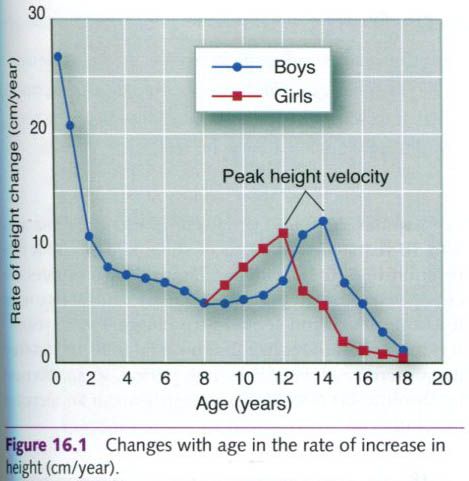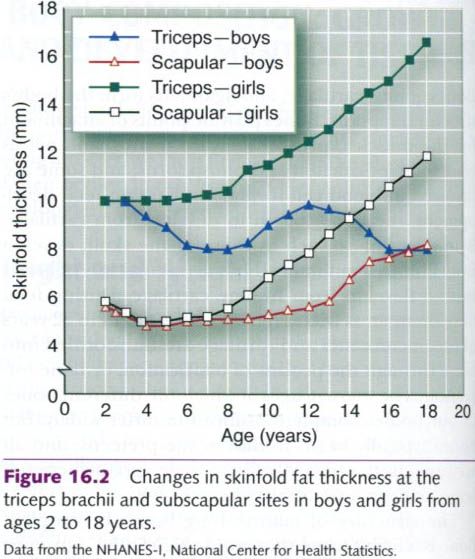Height and weight
Specialists in the field of growth and
development have spent considerable time analyzing the changes in height and
weight that accompany growth. These two variables are most useful when we
examine the rates of change. Change in height is assessed in terms of
centimeters per year and change in weight in terms of kilograms per year. Figure
below shows that height increases rapidly during the first two years of life.
In fact, the child reaches about 50% of adult height by age 2. After this,
height increases at a progressively slower rate throughout childhood; thus,
there is a decline in the rate of its change. Just before puberty, the rate of
change in height increases markedly, followed by an exponential decrease in
rate until full height is attained at a mean or average age of about 16 years
in girls and 18 years in boys. Some boys do not reach their full height until
their early 20s. The peak rate of growth in height occurs at approximately 12
years in girls and 14 years in boys. The peak rate of growth in body weight
occurs at approximately 12.5 years in girls and 14.5 years in boys – slightly
later than for height.
Bone
Bones, joints, cartilage and ligaments form the
body’s structural support. Bones provide points of attachment for muscles,
protect delicate tissues, and act as reservoirs for calcium and phosphorus; and
some are involved in blood cell formation. Early in fetal development, the
bones begin to develop from cartilage. Some flat bones, such as those of the
skull, develop from fibrous membranes, but the vast majority of bones instead
develop from hyaline cartilage. During fetal development, as well as during the
initial 14 to 22 years of life, membranes and cartilage are transformed into
bone through the process of ossification, or bone formation. The average ages
at which the different bones in our bodies complete ossification differ widely,
but bones typically begin to fuse in the preteens, and all are fused by the
early 20s. On average, girls achieve full bone maturity several years before
boys.
The structure of mature long bones is complex.
Bone is a living tissue that requires essential nutrients, so it receives a rich blood supply. Bone consists of cells distributed throughout a
matrix or lattice-type arrangement, and it is dense and hard because of
deposits of lime salts, mainly calcium phosphate and calcium carbonate. For
this reason, calcium is an essential
nutrient, particularly during periods of bone growth and in the later years of
life when bone tends to become brittle because of bone mineral loss associated
with aging. Bones also store calcium.
When our blood calcium level is high, excess calcium can be deposited in our bones for storage; and when calcium levels are too low, bone is
resorbed, or broken down, to release calcium
into the blood. When injury occurs or
when extra stress is placed on a bone, more calcium
is deposited. Thus, throughout life, our bones are constantly changing.
Weight-bearing exercise is essential for proper
bone growth. Although exercise has little or no influence on bone lengthening,
it does increase bone width and bone density by depositing more mineral in the
bone matrix, which increases the bone’s strength. There is preliminary evidence
indicating that the prepubertal years may be the most opportune time to lay
down bone in response to an exercise stimulus.
Muscle
From birth through adolescence, the body’s
muscle mass steadily increases, along with the youngster’s weight. In males,
the skeletal muscle mass increases from 25% of total body weight at birth to
about 40% to 45% or more in young men(20-30 years). Much of this gain occurs
when the muscle development rate peaks at puberty. This peak corresponds to a
sudden, almost 10-fold increase in testosterone
production. Girls don’t experience such rapid acceleration of muscle growth at
puberty; but their muscle mass does continue to increase, although more slowly
than boys’ ; to about 30% to 35% of their total body weight as young adults.
This rate difference is largely attributed to hormonal differences at puberty.
These percentage values for both men and women decrease with aging due to loss
of muscle mass and gains in fat mass.
Increases in muscle mass with age appear to
result primarily from hypertrophy(increase
in size) of existing fibers, with little or no hyperplasia(increase in fiber number). Fiber hypertrophy results from increases in the myofilaments and myofibrils. Increases in muscle length
as young bones elongate result from increases in the number of sarcomeres(which are added at the
junction of the muscle and the tendon) and from increases in the length of
existing sarcomeres. Muscle mass peaks in females at age 16 to 20 years and in
males at 18 to 25 years, unless it is increased further through exercise, diet,
or both.
Fat cells form and fat deposition starts in
these cells early in fetal development, and this process continues indefinitely
thereafter. Each fat cell can increase in size at any age from birth to death.
Early studies investigating fat cell and fat
mass development suggested that the number of fat cells becomes fixed early in
life. This led many scientists to believe that maintaining a low total body fat
content during the early period of development would minimize the total number
of fat cells that develop, greatly reducing the likelihood of obesity as an
adult. But subsequent studies provided evidence showing that the number of fat
cells can continue to increase throughout life. In light of this evidence, it
is important to maintain good dietary and exercise habits throughout life.
The amount of fat that accumulates with growth and agind depends on:
- Diet;
- Exercise habits;
- Heredity.
Heredity is unchangeable, but both diet and
exercise can be altered to either increase or decrease fat stores.
At birth, 10% to 12% of total body weight is
fat. At physical maturity, the fat
content reaches approximately 15% of total body weight for males and
approximately 15% of total body weight for males and approximately 25% for
females. This sex difference, like that seen in muscle growth, is primarily
attributable to hormonal differences. When girls reach puberty, their estrogen
levels increase, which promotes the deposition of body fat. The trend of body fat increasing with age is shown in the
figure below, which illustrates the relationship between subcutaneous
fat(measured at the triceps and subscapular sites) and age for boys and girls
from ages 2 to 18 years. The amount of subcutaneous fat is representative of
total body fat. It is important to realize that both fat mass and fat-free mass increase during period 8-20 years of
age, so an increase in absolute fat does not necessarily mean an increase in
relative fat.
Nervous system
As children grow, they develop better balance,
agility, and coordination as their nervous systems develop. Myelination of the
nerve fibers must be completed before fast reactions and skilled movement can
occur because conduction of an impulse along a nerve fiber is considerably
slower if myelination is absent or incomplete. Myelination of the cerebral cortex occurs most rapidly during
childhood but continues well beyond puberty. Although practicing an activity or
skill can improve performance to a certain extent, the full development of that
activity or skill depends on full maturation(and myelination) of the nervous
system. The development of strength is also likely influenced by myelination.











0 коментара:
Постави коментар